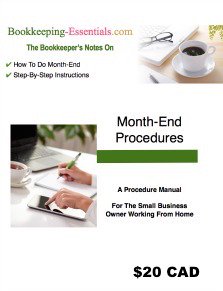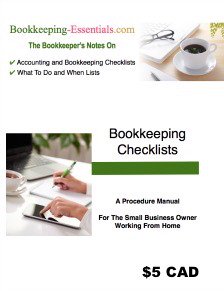The Bookkeeper's Cheat Sheet
Unscrambling the Debits and Credits
by L. Kenway BComm CPB Retired

Are you confused about all the debits and credits being thrown around? My "cheat sheet" should unscramble the confusion for you. But first you need to know ...
Every accounting transaction you see on your balance sheet and income statement must have at least one debit and one credit. It’s why you will sometimes hear it referred to as double entry accounting.
It can be very confusing because while every account can have a debit or credit posted to it, different types of accounts normally have a debit or credit balance. Clear as mud right?

GOOD TO KNOW
I really like the way Jack Sands, retired CA and CPA explains debits and credits. He says,
- Debits are what you received or what you bought (assets or expenses) or stated another way, how you used your funds.
- Credits are where the money came from or what you gave (liabilities, ownership, revenues) or stated another way your source of funds.
Every time you prepare a transaction, figure out what you received (debit) and how you paid for it (credit).
Following the logic above, we now know that assets would normally have a debit balance as they are things we buy or already have like a computer, desk or equipment.
Expenses are also debit balances because you received something whether it was phone service, retail space or photocopy paper.
Liabilities and equity would normally have a credit balance as this is where the money came from to purchase the things we have.
Sales revenue would also have a credit balance because you received cash (the debit side of the transaction) in exchange for a product or service (the where side of the transaction, in this case what you sold to a customer).
Once we have that figured out, my cheat sheet shows the following must be true:
| Normal Account Balance |
Item* | DEBIT Entry What was received |
CREDIT Entry Where it came from |
Color Accounting** |
|---|---|---|---|---|
| Debit (+) | Assets | Increases Account | Decreases Account | Green |
| Credit (-) | Liabilities | Decreases Account | Increases Account | Yellow |
| Credit (-) | Equity | Decreases Account | Increases Account | Yellow |
| Credit (-) | Sales Revenue | Decreases Account | Increases Account | Yellow with Purple outline |
| Debit (+) | Expenses | Increases Account | Decreases Account | Green with Purple outline |
*Examples of where various items belong on the balance sheet:
- Assets : Cash, Bank, Short/Long Term Investments, A/R, Prepaids, Fixed/Capital Assets
- Liabilities: A/P, Tax Payable, Accruals, Short/Long Term Loans
- Equities: Retained Earnings, Common Shares, Contributed Surplus
**If you learned color accounting, I've added the colors as a references. In color accounting, debits are green and credits are yellow while purple represents profit/income statement.
Confused - Maybe The Effect On Cash Flow Is The Problem
Where it is easy to get confused when first learning debits and credits is learning the difference between cash and non-cash entries. Many items that hit the income statement (sales revenue and expenses) do not affect your cash flow. There are also transaction that hit your balance sheet (assets and liabilities) that do affect your cash flow but not your income statement.
A cash sale increases your cash flow - cashing coming in
A credit sale (you extended payment terms) has no effect on your cash flow - there is no cash coming into the business or leaving the business. The amount sits in your Accounts Receivable. Your cash flow will increase in the future when customers pay your invoices (your Accounts Receivable). You could run into a cash crunch if you have paid your bills on time (cash left the business) but your customers have not paid you on time (cash did not come into the business to offset the cash going out).
A cash purchase decreases your cash flow - cash going out
A credit purchase (you purchased on payment terms or a credit card) has no effect on your cash flow - there is no cash coming into the business or leaving the business. The amount sits in your Accounts Payable. Your cash flow will decrease in the future when you pay your bills (your Accounts Payable). Best policy for your cash flow is to never pay bills early. Only pay on the due date.
Taking out a loan increases your cash flow - money comes into the business
Making a loan payment decreases your cash flow -money leaves the business
An Example How To Use The Cheat Sheet
How To Record a Term Deposit
Let's walk through an example of how you can use this cheat sheet to help you book your entries.
Let's say we are trying to determine the bookkeeping entry to record a term deposit? Okay, let's think our way through this small business bookkeeping entry.
First open up this cheat sheet page in a separate browser page so you can refer to it as we decide how to book this entry.
Small business bookkeeping uses double entry bookkeeping ... every entry needs debits and credits. The entry must total zero when you are finished if you want to remain balanced. So let's figure out our debits first.
- What have you received in this transaction?
You have received a term deposit.
- Is a term deposit an asset, a liability, an equity, a revenue or an expense?
I'd immediately rule out liabilities and equity because I have something ... a term deposit.
I'd also rule out revenue because I did not sell something to receive the term deposit.
The term deposit is not a service or thing I will use up in the course of the year, so I think I can rule out expense.
The deposit is something I purchased, so I'd have to go with the term deposit is an asset.
- Is it a current asset or a long term asset?
That depends on the term ... under one year, it's a current asset ... over a year, it's a long term investment.
Now let's figure out our credits.
- Where did the money come from to purchase the term deposit?
I'm guessing that the money came from your bank account, which is also an asset ... which when I look at the cheat table says it's normal balance is a debit ... and we are looking for a credit.
If I look closer at the cheat table, I can also see that an asset account can have debit and credit transactions which increase or decrease the account ... so I think I'm still okay with saying the money to purchase the term deposit came from my bank account.
This purchase will decrease money in my bank account, which the cheat table shows as a credit. Okay now I'm comfortable I've made the right choice.
Now we know enough to book our entry:
DEBIT Term Deposit
CREDIT Cash in Bank
In small business bookkeeping, it's important to learn to think your way through a transaction. Learning your debits and credits is essential to learning this task. Also becoming familiar with your chart of accounts and how to read financial statements helps if you want to master small business bookkeeping.
Another great tool to use when working your way through a complicated entry are "T-accounts". T-accounts help you think out your entries visually so you can be sure everything clears and ends up in the right spot.
Before you go, why don't you test your balance sheet knowledge.

It's been great chatting with you .
Your tutor Lake
Return to Previous Page - Confused About The Balance Sheet?
Enjoy A Tea Break With
Me Today. Let's Chat!
Use the search feature to quickly find the
information you're looking for.
Join Me On Facebook
Help support this site by "liking" me! Here's where I post current information.
Listed Under Websites NOT Local Business.
This website is NOT associated with the business operating in Bonnyville AB.



